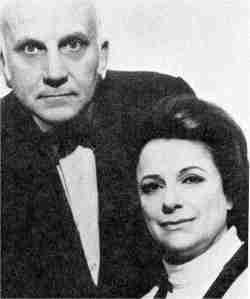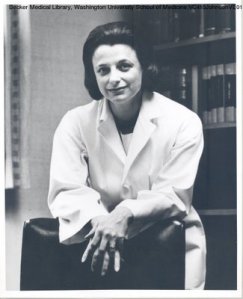Virginia Johnson, of Masters & Johnson, pushed for a better life and ended up revolutionizing the way the world looked at– and practiced– sex. She wasn’t a physician or an academic. She was simply a woman who wasn’t afraid to give her perspective on sex, in a field full of men who already thought they knew everything there was to know.
Born Virginia Eshelman in Springfield, Missouri on February 11, 1925, Virginia’s parents moved to California for a brief time during the depression, but wound up back in Southwest Missouri, settling in Golden City. Viriginia finished school two years early and studied music at Drury University. Eventually she moved to Jefferson City– where her mother felt she had better chances of meeting a man– and attained a secretarial position. She also found work singing with bands during World War II, and performed for soldiers at Fort Leonard Wood. At 22, Virginia married a lawyer in his 40s from West Plains, but she quickly grew tired of small town life. She left her husband and moved to St. Louis, where she met George Johnson, a musician who performed in nightclubs around the city.
Virginia and George married, and had two children together, but she found herself again wanting more. She wasn’t satisfied being a bandleader’s wife. Although she loved her kids, she found herself in a situation familiar to many women of the 1950s: She was unsatisfied being cast in the role of wife and mother. “Gini had a commanding presence,” a colleague later said. “She was sort of muscular and stood in a way that made you feel she was tough. She sort of leaned forward toward you. She wasn’t laid back, wasn’t quiet. Her wishes had to be known.” In many ways, Virginia Johnson was a force to be reckoned with. If she was unhappy with her circumstances, she was going to change them.

So it was that Virginia Johnson who found herself 32 years old, divorced twice, and caring for two young children. Washington University was her fresh start – a degree in Sociology would be the change she needed. The job she took there as Dr. William Master’s research assistant lowered her tuition fees and gave her a steady income.
Viriginia’s duties at Washington University’s Obstetrics and Gynecology department started out strictly secretarial. She set appointments, filed insurance claims and did other menial jobs around the lab. William Masters was performing secret exhaustive research, research that even Virginia didn’t know the details of for some time. In the 1950s, Masters paid prostitutes to have sex with men in his laboratory at the University, where he could observe the human body’s physiological responses to sexual stimuli. The University community knew something untoward was going on, but no one knew exactly what.
The prostitutes that Masters paid introduced him to the concept of a fake orgasm. The idea of a woman faking an orgasm had never crossed his mind. Masters realized that his research needed a female perspective. Virginia, who by this time had discovered exactly what was going on in Masters’ labs, was not appalled by his research, but rather intrigued. She approached the situation pragmatically, and provided the female viewpoint that took the research from the University’s dirty little secret to a groundbreaking work that would change the world, and revolutionize sex for women.
Masters took Virginia Johnson under his wing and treated her as an equal. While she never received a college degree, he trained her in medical terminology, therapy and research. He gave her equal credit in all their publications. Masters’ research was seen as so controversial, that Washington University ceased to back him in the 1960s. He and Johnson forged out on their own, establishing the Reproductive Biology Research Foundation (which would later become the Masters and Johnson Institute), a non-profit organization dedicated to sex research. Their work continued with no government or academia support.

But Virginia’s sudden step up in the world came at a price: Masters also expected her to provide him with sex. In the early days at the University, he argued that if they were observing sex on a day to day basis, they needed to use each other as an outlet for pent up desire, rather than turning their desire to research subjects and altering their findings. Sex between William Masters and Virginia Johnson wasn’t carried out in the comfort of hotel rooms. It happened in the clinic that Masters used for his research. Virginia was never completely on board with it, but it was the 1950s, and there were no sexual harassment laws in place to protect her. She later said, “No, I was not comfortable with it, particularly, I didn’t want him at all, and had no interest in him… I was in an emergency situation and the perks kept coming along.”
After 10 years of working together, Masters’ and Johnson’s book, Human Sexual Response. was released in 1966. In it, the researchers outlined four stages of human response to sex. The book exhaustively detailed the female biological response to sex, coming to the conclusion that women were naturally multi-orgasmic, while men were not. It also treated female sex organs as their own entity, not just defined in terms of male sex organs. Work of this nature was revolutionary. Women and men were now armed with greater information about how to relate to each other, and how to perform and be satisfied sexually. Although highly controversial, the book quickly earned the approval of the Journal of American Medical Association, making it standard reading for the medical field. Masters and Johnson followed up with a second work, Human Sexual Inadequacy, in 1970. The highly lauded book identified strategies to combat sexual deficiencies.
Masters and Johnson added marriage to their partnership in 1971. Virginia had been dating an international businessman at the time, and some think that Masters enticed her into marriage to secure his research partner. Whatever the motives, their marriage in some ways marked the end for their professional partnership. They were still conducting research at their institute, and providing very expensive sex therapy to couples, when Masters released two books that Virginia and the Institute’s other researchers didn’t necessarily support: Homosexuality in Perspective, where Masters argued that homosexuality could be cured, and CRISIS: Heterosexual Behavior in the Age of AIDS, where he argued that the Health Department was hiding information that AIDS was still a very present threat in the late 1980s. Both of these books chipped away at the reciprocal relationship Virginia had had with William Masters. Masters could not back up his books with solid scientific research, and Johnson could not publicly defend him. Their marriage lasted until 1992, when William Masters left Virginia Johnson to marry his childhood sweetheart.
Despite their troubled personal– and eventually professional– relationship, Masters’ and Johnson’s research freed Americans sexually. It inspired and was fueled by the sexual revolution of the 1960s and 70s. Never before had any attention been paid to females as an equal participant in sex. After three failed marriages, the secrets of love and attraction may have remained a mystery to Virginia Johnson but she provided a voice to women everywhere when it came to sexuality.
The Masters & Johnson Institute was located at 4910 Forest Park Boulevard
Virginia Johnson’s location on the St. Louis Walk of Fame
All quotes in this blog post were taken from the book: Masters of Sex: The Life and Times of William Masters and Virginia Johnson by Thomas Maier
Interesting. Where did you get the personal information about M&J’s personal relationship? Where is she now? I lost touch with her a couple years ago and heard she was in a nursing home. Never knew her children, although I know her son was in St. Louis and she wanted to go back and visit Golden City.
A lot of it came from Thomas Maier. He interviewed her for his book a few years ago. I asked him if he knew where she was now and he said he had lost touch with her. I’d like to find out.